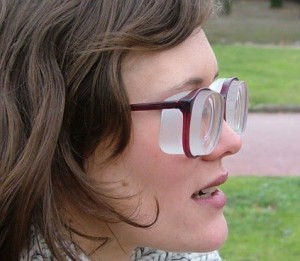What Does High Index Lens Mean?
“High index lenses” are, simply put, eyeglass lenses that are made of high index material.
High Index Lenses
 I know, that’s an answer that begs the follow-up question: what is high index material? High index material, available in either plastic or glass, is the result of a composite chemical process and creates a lens material that has more refractive power than standard plastic or glass. Because of this, high index lenses use less physical material to grind out a prescription. This means that stronger prescriptions can be made lighter and thinner when formed from high index material… which can be (depending on the strength of your prescription) a very big deal indeed.
I know, that’s an answer that begs the follow-up question: what is high index material? High index material, available in either plastic or glass, is the result of a composite chemical process and creates a lens material that has more refractive power than standard plastic or glass. Because of this, high index lenses use less physical material to grind out a prescription. This means that stronger prescriptions can be made lighter and thinner when formed from high index material… which can be (depending on the strength of your prescription) a very big deal indeed.
The stronger a prescription is, the more pronounced the difference in weight and thickness of the lens material can be. Prescriptions cut from standard plastic or glass are relatively thick and heavy when compared to the same prescription cut from a high index material. Therefore, the benefits of high index lens come into play mostly when they are used in conjunction with higher prescriptions.
Besides the weight and thickness issues, strong prescriptions historically present two other unique problems for those who require them. First, very thick lenses often distort the look of a wearer’s eyes, either magnifying them to produce a “bug eye” effect or magnifying the area around them, making the eyes appear tiny by comparison. Secondly, thick lenses sometimes do not fit well or at all in certain frame styles. Because the thickest part of a lens is at the edge, thicker frames are necessary to cover protruding lenses. Some frame styles, such as rimless frames, cannot support lenses above a certain thickness.
If any of the above issues apply to you, there’s a good chance you’ll find some relief if you chose high index lenses. Just be aware that high index material has some built-in disadvantages, as well. These include:
- Higher Cost. The process of producing high index material is simply more expensive, and higher variances means less room for error when generating a prescription…hence wasted material.
- Lower Abbe Value. “Abbe value” is a measure of distortion, with higher ranges having less distortion. High index lenses have a lower Abbe rating than identical prescriptions formed from standard material. So while the thinner, lighter high indexes offer cosmetic benefits, they do not surpass traditional lenses in vision quality.
- More Brittle in Glass Form. High index lenses in glass form are more brittle than standard glass lenses.
- More Reflective. High index lenses tend to reflect more light than standard material lenses. An anti-glare coating is recommended if high index lenses are selected.

The positives of high index lenses, especially if you have a strong prescription, can often outweigh these negatives. The choice is up to you. Contact us if you have any questions about which type of material is the best fit for your individual vision needs.
Leave a Reply
You must be logged in to post a comment.


-21 high index glass